A coin grade describes a coin’s:
1) authenticity,
2) potential problems, and
3) fineness, or nearness to perfection.
This coin grade has a significant impact on the coin’s perceived value to collectors.
Most people talk about coin grade as a number describing fineness. However, authenticity and problems or potential problems are critical to coin valuation. When professional third-party coin grading and certification services like PCGS and NGC assign and certify a coin a grade, they guarantee that coin as authentic unless they state otherwise. Likewise, they guarantee a coin to be problem-free unless they specifically note problems or potential problems.
If you’re unsure about your coin grade or authenticity (and most non-numismatists are unsure), the Academy of Coins© has created an easy, quick, low-cost grading service alternative at PriceThatCoin.com.
PriceThatCoin.com is a much less expensive way to find out the value of your coin than traditional coin certification. And if you should certify your coin, we’ll tell you!
If you would prefer to learn about coin grading and valuation yourself, read on…
#1) Authenticity
With ever-more sophisticated counterfeiters producing fake coins, the stakes are higher than ever to ensure that coins, which are traded heavily on a hyperactive market, are indeed legitimate.

This is an authentic silver 1803 Dollar currently valued around $2000.
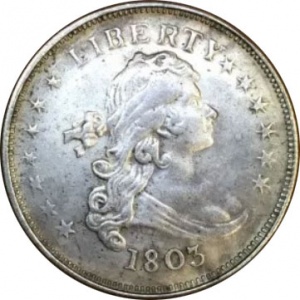
This is an easily identified counterfeit 1803 Dollar currently valued around $0.25. It is illegal to buy or sell counterfeit coins in the United States unless they are clearly marked “COPY”.
#2) Problem Coins
The difference between a problem-free coin and one with a tiny problem may translate to a huge difference in demand from collectors, which may translate to a substantial percentage difference in market price.
#3) Fineness
This is what most people think of when they say, “coin grading.” Authentic, problem-free coins tend to be valued by their fineness grade. The difference between the market demand for a coin graded one point higher than another, otherwise similar example, may translate to a difference of a few dollars or a few hundred-thousand dollars.
All of this comes down to the art and skill founded upon years of experience picking apart tiny details in coins called, ‘coin grading.’
The fineness grade generally describes how much of the original design is showing compared to imaginary perfection. That imaginary perfection is dependent upon the technology used to create the coin. The older the coin, the lower the bar for that imaginary perfection.
Numismatists grade Vintage (1700-1981) and modern (1982 – present) coins on a 70-point scale that is intended to describe fineness, centering, and surface conditions at the same time, accounted for in one numerical grade. Some coin types also have qualifiers that help describe appealing characteristics for strike and die state. Proof coins are also graded with a description of the impression of die freshness. This description, for example Cameo or Deep Cameo, describe how much contrast is apparent between the design devices and the empty fields around those devices.
Aside: Ancient coins are graded separately on fineness (how much original detail is showing), centering (strike) and surface condition. Our discussions center around vintage and modern United States coins.
The way professionals grade coins greatly helps to determine their value in the numismatic market. Third-party coin graders came about because of a substantial need for disinterested professional opinions. The market needed professionals to describe coins fairly, without influence from buyer or seller. The TPGs do not exist to influence the market, though they do by necessity as a result of their actions.
How Do You Grade a Coin?
Authenticating Coins
Determining a coin to be authentic or counterfeit is a skill that may take years and significant technology to master. Many counterfeit coins are obvious while others are extremely difficult to differentiate from authentic, requiring advanced technology, microscopes, and considerable training. Authenticating coins should be left to professionals, though amateurs can often spot obvious counterfeits without difficulty.
Identifying Coins with Problems

An example of problem coin an amateur numismatist should be able to spot: an 1839 Seated Half Dollar that has been harshly cleaned. This coin might sell at auction for around $100.
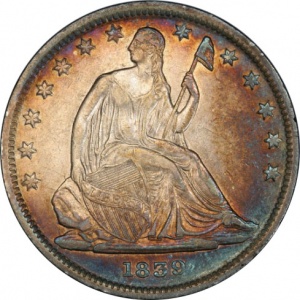
An example of problem-free coin: an 1839 Seated Half Dollar, also just slightly higher grade than the problem example above, but with beautiful natural album toning. This coin might sell at auction for around $280.
Amateurs can often spot obvious coin problems like polishing, harsh cleaning, significant damage (including environmental damage), and graffiti. Skilled professionals are often required to differentiate doctored coins, which have problems because a skilled and devious individual has attempted to mask problems. Some examples of doctored coins include: coins that are artificially toned, aged, or worn, plugged and holed coins, coins with filed rims, and others.
Grading a Coin for Fineness
Amateurs can sometimes, with practice of grading hundreds of coins in many different conditions, loosely grade coins. There are some coins that require substantial skill because of the way they were made, or because they are on the cusp of two different grades. Skilled professionals should be trusted with assigning numerical grades.
It takes years to develop the skill that is the art and science of coin grading.
In the 1950s, Dr. William Sheldon came up with a 70-point scale for grading coins. It’s far from perfect (this author would greatly prefer a 100-point scale), but the coin industry adopted the Sheldon Grading Scale.
Coins graded from 0 to 58 in the current system show some signs of circulation, or use as actual monetary devices – as coins. Circulated coins are ones that a person used to purchase an item. As a result of being put in a change drawer or purse, or being kept in a pocket, the coin has its design’s highest points rubbed (worn) away. The wear can be ever so slight (Almost Uncirculated / About Uncirculated 58) and barely noticeable all the way down to a flat metal disk with barely any design discernible (Poor 1).
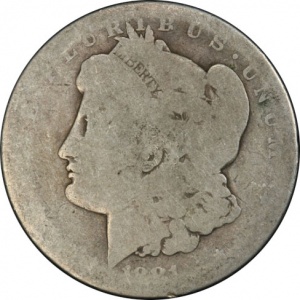
An 1881-S Morgan graded Fair-2. This coin has a current market value of about $18, which is in great part determined by the coin’s bullion value of about $13.
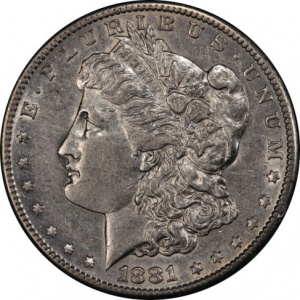
An 1881-S Morgan Silver Dollar graded Extremely Fine-45. This coin has a current market value of about $25. Uncertified, the coin is worth around $20. It is easy to discern the Fair coin from the Extremely Fine one, even for an amateur.
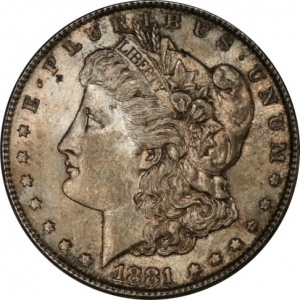
An 1881-S Morgan Dollar graded Almost Uncirculated-58. This coin has a current market value of about $35 when certified by a major TPG. Uncertified, it might sell for $20 to $25. For some, it is more difficult to discern Extremely Fine from Almost Uncirculated. In this case, the value difference is small.
Coins graded from 60 to 70 were never used in circulation, and are considered to be as the Mint presented them for consumption and use. They are called “Uncirculated” or “Mint State”. The lower the grade, the less there is of the original design. Despite the lack of use in the real world, the coin is dinged up from the minting process and storage or transport in bags, but has no discernible wear from circulation use. The higher the grade, the closer that coin is to being the ‘perfect’ example of its type. (And usually, the higher the grade, the more valuable the coin is to collectors.)
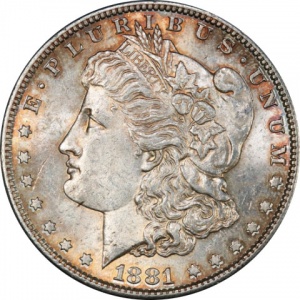
An 1881-S Morgan Dollar graded Mint State 62. This coin has a current market value of about $50 certified by a major TPG. Raw, the coin would sell for $25 to $30 For some, discerning lower Mint State grades from Almost Uncirculated is extremely difficult. There are types of coins which are much more difficult to grade around this cusp because its strike (how it was manufactured) is uneven. It’s important to get it exactly right because the value to the market is often drastically different when the coin is Mint State compared to Almost Uncirculated.
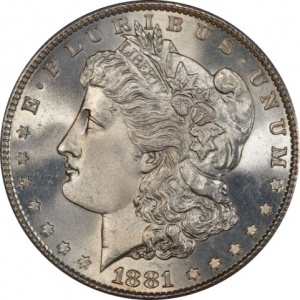
An 1881-S Morgan Dollar graded MS-66. This coin has a current market value of about $180.
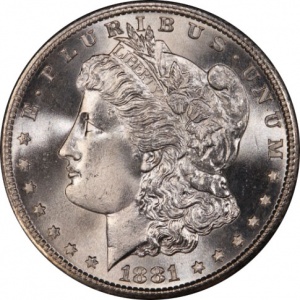
An 1881-S Morgan Dollar graded MS-68. This coin has a current market value of about $4500.
The Coin Grade: A Sight-Unseen Description to Estimate a Coin’s Value
Each of these pieces of coin grading help to define the state of the coin – its authenticity, presence of problems, and its fineness. Taken together, they help collectors understand the coin’s potential value to them and how desirable that type of coin is to the market. As such, coin grading helps to define the market value for coins, so it’s crucial that you have your coins graded by a highly experienced, disinterested third party, whether you’re buying or selling them.
Some Coin Grading and Valuation Examples:
1943 Lincoln Wheat Cent
When dealing with extremely common coins like 1943 Lincoln Wheat Cents (silvery in color, made in zinc-coated steel), the difference between a grade of Extremely Fine 40 and Almost Uncirculated 55 is just a few cents on the active market.
1921-D Morgan Silver Dollar
But when we’re dealing with conditional rarities like a 1921-D Morgan Dollar in Mint State 66, the difference of one point (MS-66 or MS-67, or MS-64 or Mint State 64 Deep Mirror Prooflike) can mean the difference of tens of thousands of dollars.
Correlating Grade to Value with Numismatic Price Guides:
There are many coin price guides available for low cost or for free. Given an authentic, problem-free coin that has been fairly graded, these price guides estimate the value of a coin on the market. Price guide pricing is usually based on past auction resulted and recorded dealer sale prices.
The Red Book
The most famous is Whitman Publishing’s Red Book. It is published every April with prices for the following year (the 2010 edition was printed in April of 2009). Because the pricing is so out of date, the Red Book is really only used as a general reference. As a general numismatic reference, it is an outstanding guide! As a price guide, its accuracy leaves much to be desired. It is useful, however, to get an idea of relative values of coins in differing grades. The Red Book‘s prices are generally high (top-of-market retail values), and they sometimes lack accuracy. However, studying the relative price differences between coins and grades is an excellent way to gain a basic understanding of the market for a coin type.
In other words, a 1927-S Peace Dollar may not trade for exactly $200 in Mint State 60, as it is purported to do so in the Red Book. But at a quick glance, you can see that a 1928 Peace Dollar is more than two-and-a-half times as valuable than a 1927-S in the same grade. This is loosely true. You can also see at a quick glance that a ’27-S in Almost Uncirculated 50 is worth less than half of one graded Mint State 60, while one in Choice Mint State, MS-63, is worth three times as much as one in MS-60. These are great guidelines to use while researching coin prices and recent auction records.
You can get a copy of the Red Book at any coin shop or book store, and eBay always has copies. The retail price of the current year Red Book is usually under $20, depending on the version you prefer.
The Grey Sheet (CDN)
Most coin dealers use the Coin Dealer Newsletter (otherwise known as “the Grey Sheet” price guide) as a basis for pricing coins as it is updated monthly. An active subscription is hundreds of dollars per year.
Online Price Guides – PCGS, NGC, FMV
There are some very accurate and incredibly useful price guides available online, also. PCGS and NGC, the two top grading companies, put out their own. Most consider PCGS to be a little high, whereas NGC’s price guide is almost always very high compared to market.
FMV is an independent price guide that many dealers reference.
Where Price Guides Fail: Problem Coins, Eye Appeal, Stickers & Holders
Most price guides are a great general reference. However, there are times that they are more or less useless in terms of real market value.
Problem Coins
One example of price guides not telling the whole story is with problem coins. Problem coins, whether in a TPG holder or not, typically have substantially less demand than problem-free examples. As such, the price guides are not accurate for coins with problems. These problem coins may be in TPG coin holders (also called “capsules”, and “slabs”). If the TPG found a problem with the coin, they mark it “Details”. Sometimes, TPGs miss, ignore, or net grade minor problems. Coins that clearly have problems are typically in much lesser demand on the market, and bring substantially lower auction prices than graded coins with no visible problems. Anybody who tells you that “it’s such a rare coin, it doesn’t matter” is lying to you. The only time that happens is if there are literally no problem-free coins of that type and grade in the market.
Eye Appeal
Another example of price guides failing is when coins have exceptionally bad or exceptionally good eye appeal. Coins with ugly toning or badly-placed marks and scratches that are still gradable are usually treated as problem coins by most collectors. Coins with outstanding, beautiful, natural toning have values in the real numismatic market that are not reflected in price guides.
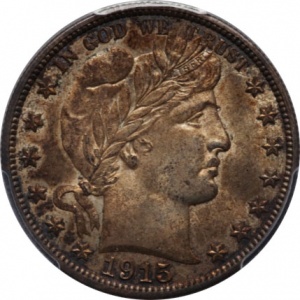
This 1915-D Barber Half is graded MS-64. Its darkly toned surfaces didn’t help it at auction, where it sold for around $1000, or over $100 below most price guides (about on par).
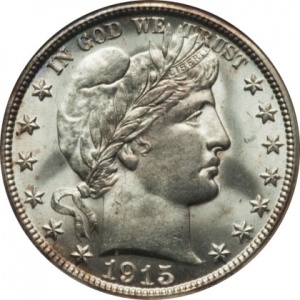
This 1915-D Barber Half is also graded MS-64. Its bright original surfaces helped it stand out at auction, where it sold for around $1400, or over $300 above most price guides.
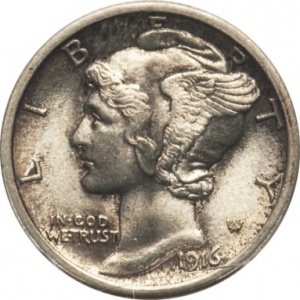
This 1916 Mercury Dime is graded Mint State 65 Full Bands. Its natural, original subtle toning made it common, so it brought around $120, or well below price guide.

This 1916 Mercury Dime is also graded Mint State 65 Full Bands. Its beautiful rainbow target toning was attractive to bidders, where it sold for around $280, or over 20% above most price guides. Two coins, one grade, two very different prices.
Stickers
Price Guides often do not reflect coins with market-accepted stickers on market-accepted TPG slabs. The best example of “stickered” coins are CAC coins. These are coins graded by either PCGS or NGC, and have a green CAC sticker. The sticker tells the market that CAC agrees with the grade, and further feels this coin is a premium quality example. CAC coins usually bring prices much higher than price guide. The Grey Sheet has pricing for CAC coins, and it is often more accurate than other price guide options for CAC coins.
TPG Certified Coins
Coins graded and certified by a major Third-Party Grading company like PCGS or NGC are typically more fluid on the market. They typically bring values higher than ungraded, uncertified, or “raw” coins. For lower value coins, the cost of grading often plays a part in determining the market value. For example, Statehood Quarters in Mint State 64 are plentiful and can be bought in original bank rolls for 25 cents from the right bank. However, a Statehood Quarter graded and certified MS-64 by PCGS or NGC might have a value of $5 to the numismatic market because certifying the coin grade cost more than $5.
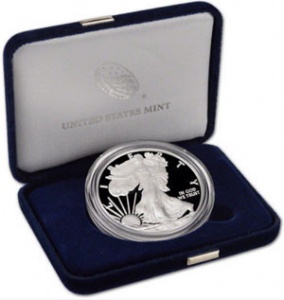
A 2018-W Proof American Silver Eagle, in original mint packaging. These coins routinely sell for $50 to $60 shortly after they are released by the Mint because that’s close to the Mint’s retail price.
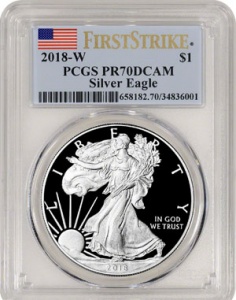
2018-W Proof American Silver Eagle, PCGS First Strike. These coins routinely sell for $70 – $80 right after they are issued and graded. The “First Strike” designation in no way reflects how fresh the dies are, or how early the coins were made. It’s given to coins released by the Mint first, which bares no correlation to their time or order of production.

2018-W Proof American Silver Eagle, PCGS, with a label hand-signed by former Mint Director Ed Moy. These coins now routinely sell for $80 to $110, but the long term valuation is always interesting to follow.
Another way price guides don’t reflect values of TPG holdered coins is in the label inside the holder. The best advice is most often, “buy the coin, not the holder”. But sometimes the TPGs engage in marketing activities including limited-run labels inside their slabs with coins, and some collectors find these labels appealing. Many times, these holders carry a premium over the accepted market price for the coin to collectors. Often, dealers do not respect these premiums. Most price guides do not reflect label pricing, though a TPG’s own price guide may attempt to address these value differences.
Counterfeit Coins:
Counterfeit U.S. Coins have no value in the U.S. coin market besides being novelty items. They are illegal to purchase and illegal to sell, unless they are clearly marked “COPY”. There are collectors who collect fake coins as learning tools, but they usually will not spend much money for them. If a collector of fakes really must have a new example counterfeit for their collection, they may spend $1 to $2.
Having Your Coins Graded or Certified
If you have a coin you know nothing about, one option is to pay a lot of money to a Third Party Grading company to get an unbiased opinion out about it. This may take days or months, and cost between $20 and $1000 depending on the cost of the service you choose and the value of your coin. Another option is to find free advice from friendly coin dealers or collectors. Determining whether it makes sense to spend time and money to have a coin certified is usually difficult for any novice lacking experience with the coin market.
Coin grading is a critical aspect of collecting, and is important for the whole numismatic market. Understanding how to grade effectively takes the average grader tens of thousands of coins and many years to learn. It is an art and a science that can be deceptive to the newcomer. It’s often quite easy to know just enough to get yourself in a lot of trouble. Go carefully, and deal with only reputable, knowledgeable advisers.
Next: Coin Condition Part 2: A Deeper Look into Problem Coins
